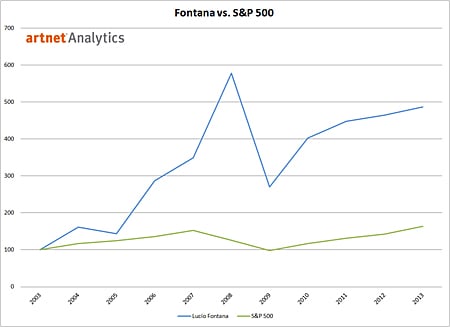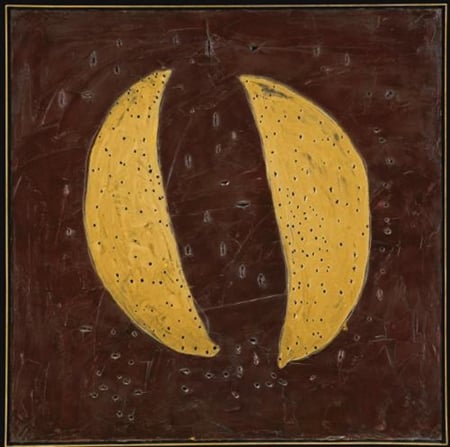Auctions
Artist Index: Lucio Fontana
artnet Analytics takes an in-depth look at the art market for Lucio Fontana.

artnet Analytics takes an in-depth look at the art market for Lucio Fontana.


Lucio Fontana, Concetto Spaziale, Le Chiese di Venezia, 1961, sold for US$6,822,780 at Sotheby’s London
This week artnet Analytics takes a look at Italian painter and sculptor Lucio Fontana (Argentinian/Italian, 1899–1968) and his market. Fontana was born in Argentina, but moved to Milan at a young age and later trained at the Accademia di Brera under the tutelage of Adolfo Wildt (Italian, 1868–1931), a sculptor devoted to the aesthetic characteristics of the Novecento Italiano group. As a result, Fontana’s early sculptures, including The Harpooner (1934), reference the traditional and classical vocabulary sought by the Novecento Italiano movement.
Fontana, however, slowly shifted away from these figurative elements towards abstraction. During World War II, he returned to Argentina where he began to develop his theory on the concept of space. In 1947, he founded Spazialismo and defined the movement through five manifestos. It was at this point that Fontana made a clean break from Figurative Art.
These works, generally titled Concetto spaziale, comprise the most iconic portion of Fontana’s oeuvre, and can be divided into two primary categories: Buchi (holes) and Tagli (slashes). These works focus on the idea that art should include an element of energy and dynamism. By slashing and puncturing the picture plane, a gesture that stands opposed to the traditional treatment of canvas, Fontana creates a three-dimensional work that engages the viewer and plays with the idea of space and transition. In some cases, he adds dimension by peppering the surface with objects such as broken glass and sand. These techniques also find their way into Fontana’s sculptures. For example, the spherical series, titled Nature, includes distorted spheres plagued with gashes and holes.
Fontana’s work is often considered a precursor to the Environmental and Land Art movements. In 1966, Fontana was awarded the Grand Prize for Painting at the Venice Biennale.

Lucio Fontana vs. S&P 500 2003–2013
Nearly 45 years after his death, the market for Fontana continues to show signs of significant growth. The 2013 auction season has already proven to be a strong one for Fontana, with the top 10 lots of 2013 realizing over US$35 million. To draw a comparison, the top 10 Fontana lots of 2003 only generated approximately US$5.5 million. Additionally, Concetto Spaziale, Le Chiese di Venezia (1961) sold for nearly US$7 million in June 2013 at Sotheby’s London, making it the fifth most expensive work by Fontana sold at auction.
The graph above tracks Fontana’s performance at auction against the S&P 500 over the past 10 years. Since 2003, Fontana’s overall market performance has outdone the S&P 500 and shown signs of recovery after the financial crisis of 2007–2009.
For more information about the methodology of artnet Indices, please see the artnet Analytics White Paper.
Need additional analysis? artnet Analytics can work with you to create even more customized reports based on the specific needs of your auction house. For more information about custom reports, please contact Katharine Markley at [email protected].